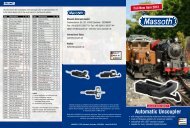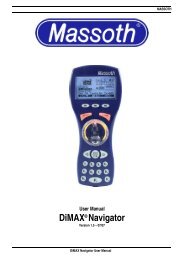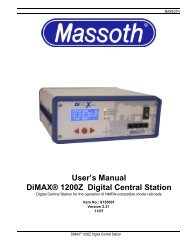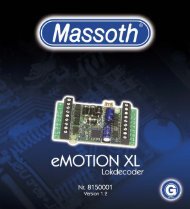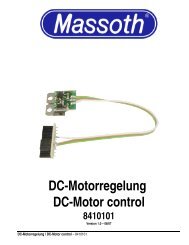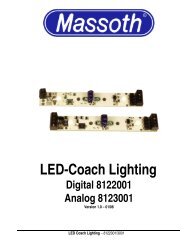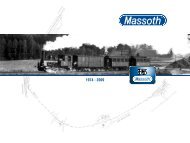DiMAX Navigator
DiMAX® Navigator - Massoth
DiMAX® Navigator - Massoth
You also want an ePaper? Increase the reach of your titles
YUMPU automatically turns print PDFs into web optimized ePapers that Google loves.
MASSOTH<br />
12. Glossary<br />
• Bit<br />
The word “bit” is the truncated form of the term “binary digit.” A bit is the smallest unit of digital data,<br />
having a value of either “0” or “1.” Eight bits form one “byte” of digital information.<br />
• Booster<br />
A booster amplifies a low power DCC signal, providing additional power to the model railway. Each<br />
booster supplies a single, isolated ‘power district’ on the layout.<br />
• Bus / Bus system<br />
A bus system is the electrical connection or data highway between control components of a DCC<br />
system. The various bus systems being currently utilized by different manufacturers are typically not<br />
compatible. For example, the bus system for Massoth components is called the <strong>DiMAX</strong> bus. The bus<br />
system for Lenz is XpressNet. The bus system for Digitrax is LocoNet. Each features a separate and<br />
distinct communication protocol.<br />
• Byte<br />
A byte is a unit of computer information consisting of eight bits. The decimal value of a byte varies<br />
between 0 and 255.<br />
• Central Station<br />
The central station is the brain of a digital system. All commands, feedback instructions, etc., are<br />
processed in the central station. The central station generates the bi-polar DC waveform which is<br />
subsequently amplified by a DCC booster to power the track bus. The central station communicates<br />
with DCC components – cabs, wireless receivers, feedback modules, etc - via the bus system<br />
(<strong>DiMAX</strong>, LocoNet, XpressNet, etc.).<br />
• Computer Interface or PC Interface<br />
A computer interface allows the user to connect a digital system to a computer. Typically, the<br />
interface is a 9-pin serial connector. With appropriate software, the computer can be used to control<br />
the model railway. Many advanced digital systems include an integral computer interface.<br />
• CV – Configuration Variable<br />
DCC decoders allow the user to program various settings through the use of configuration variables<br />
or CVs. A CV consists of one byte (eight bits) of information and may have a value between 0 and<br />
255.<br />
• CV-Programming, Direct Mode CV Programming, (DM)<br />
CV settings may be changed by a process called CV programming. Direct Mode Programming is<br />
typically conducted on an isolated, low power (current-limited) programming track section.<br />
Programming can be accomplished in bit-by-bit mode (allowing one of the eight bits to be altered) or<br />
in complete byte mode (allowing the whole byte - all eight bits – to be altered). The <strong>DiMAX</strong> system<br />
also allows the user to read the value of CVs.<br />
<strong>DiMAX</strong> <strong>Navigator</strong> User Manual 37



